Marsupials: Animals have inhabited the earth since time immemorial. Alongside humans, animal species have lived in the environment for years, till current times.
To be aware citizens and knowledgeable humans, we need to learn about various types of animals that live alongside us, on Earth. Some of which contains animals with pouches which are also known as marsupial animals.
These animals are dispersed throughout the different environments and habitats across the world and marsupials in Australia and marsupials in America are all a part of it.
In this specific article, we have prepared an exclusive list of marsupials for your increased convenience, to help you answer questions such as ‘is koala a marsupial? We hope this article aids you further.
Study the most important English Vocabulary Words identified by our experts and learn the right vocabulary to use in your day to day conversations
List of Marsupials
Name of Marsupials
List of Marsupials
- Bilby
- Cuscus
- Dunnart
- Kangaroo
- Kangaroo Rat
- Koala
- Mulgara
- Numbat
- Opossum
- Planigale
- Quokka
- Quoll
- Sugar Glider
- Tasmanian Devil
- Tree Kangaroo
- Wallaby
- Wombat
Description of the Marsupials on the list
Bilby
The Greater bilby, or alternatively known as Australia’s Easter Bunny, is a ground-dwelling unique bandicoot species of marsupial.
This species is kangaroo-like and has a large body, hairless ears, and long, slender hind legs that give the animal a rather funny appearance. The marsupial fur is soft and smooth and colored with bluish to grey, exhibiting thin, tan to brown-colored patches.
The belly area of the animal is whitish, whereas the slender and hairless snout appears pink. The long tail of the bilby is greyish at the base, which gradually turns to black and ends with a white, exposed tip, which has a tuft of long hairs. While galloping, the animal pulls its tail behind itself like pulling a stiff placard.
| Kingdom | Animalia |
| Phylum | Chordata |
| SUBPHYLUM | Vertebrata |
| CLASS | Mammalia |
| INFRACLASS | Marsupialia |
| ORDER | Peramelemorphia |
| FAMILY | Thylacomyidae |
| GENUS | Macrotis |
| Scientific Name | Macrotis lagotis |
Cuscus
The Common spotted cuscus is a widespread marsupial, which is about the size of a typical house cat. It has a roundish head, hidden small ears, dense fur, and a sturdy tail to climb. The species’ eyes vary in color from yellow and orange to red and are slit very similar to a snake’s eye.
All four limbs of the species have five digits and solid, curved claws, except the first finger on each of their foot.
The undersides of its paws are naked and striated, which also helps the species to grasp trees and food. The Common spotted cuscus has heavy, woolly fur, which varies in color depending on their age, sex, and their initial birth location.
Males of this species are typically grey or white or brownish to whitish coloured fur with spotted patterns on their back and a milky white under belly, and only the males are seen to have spots. Females are habitually white or grey and unspotted.
| Kingdom | Animalia |
| Phylum | Chordata |
| SUBPHYLUM | Vertebrata |
| CLASS | Mammalia |
| INFRACLASS | Marsupialia |
| ORDER | Diprotodontia |
| FAMILY | Phalangeridae |
| GENUS | Spilocuscus |
| Scientific Name | Spilocuscus maculatus |
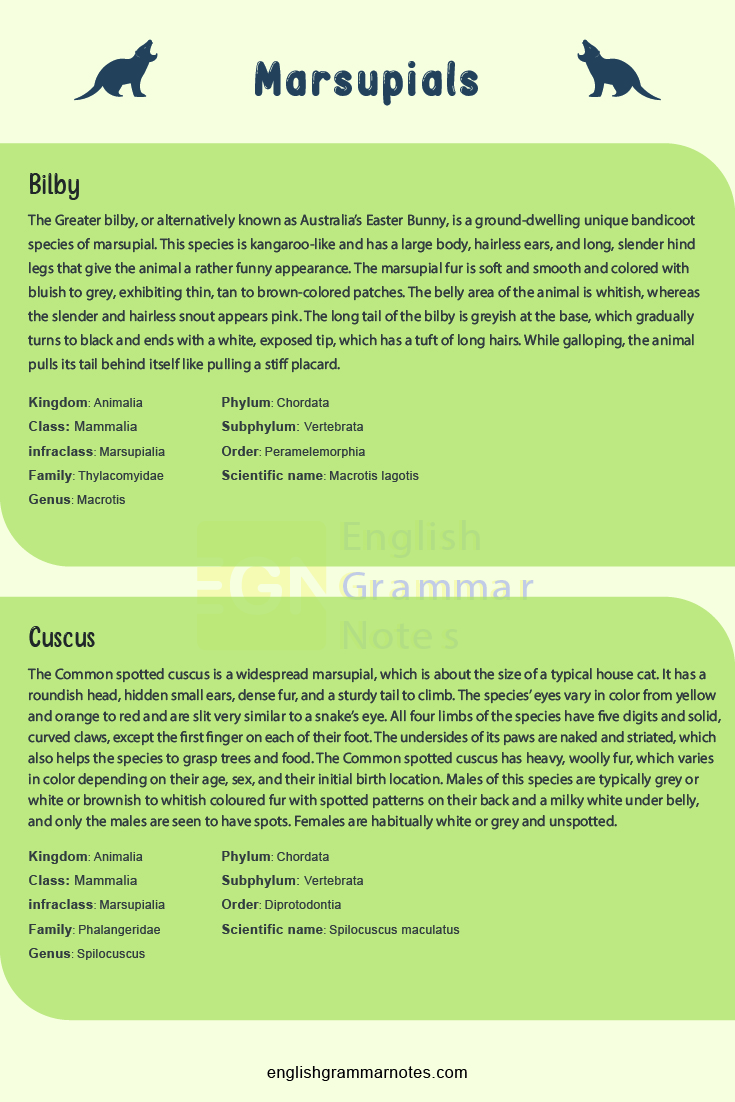
Dunnart
The fat-tailed dunnart species are small, mouse-like marsupial species that are closely related to the quolls and Tasmanian devils. These species have eyes and ears that are large, with a pointed snout and a thick tail.
During periods of sufficient food, they store fat in their tails for a short duration, due to which their tails become swollen, shifting towards becoming thinner during the winter season. These fat stores allow dunnarts to endure food shortages.
| Kingdom | Animalia |
| Phylum | Chordata |
| SUBPHYLUM | Vertebrata |
| CLASS | Mammalia |
| INFRACLASS | Marsupialia |
| ORDER | Dasyuromorphia |
| FAMILY | Dasyuridae |
| GENUS | Sminthopsis |
| Scientific Name | Sminthopsis crassicaudata |
Kangaroo
Antilopine kangaroos are giant, sophisticated kangaroos with slender faces and doe-like eyes. Males of the species have reddish-tanned upper parts and are whitish below, while their upper parts of especially females, are generally colored pale gray.
Both the feet and paws of the females are white on the underside and black-tipped. Males have a well-defined lump on their nose above their nostrils, likely used for cooling, and are also much significantly larger than females.
| Kingdom | Animalia |
| Phylum | Chordata |
| SUBPHYLUM | Vertebrata |
| CLASS | Mammalia |
| INFRACLASS | Marsupialia |
| ORDER | Diprotodontia |
| FAMILY | Macropodidae |
| GENUS | Macropus |
| SUBGENUS | Osphranter |
| Scientific Name | Macropus antilopinus |
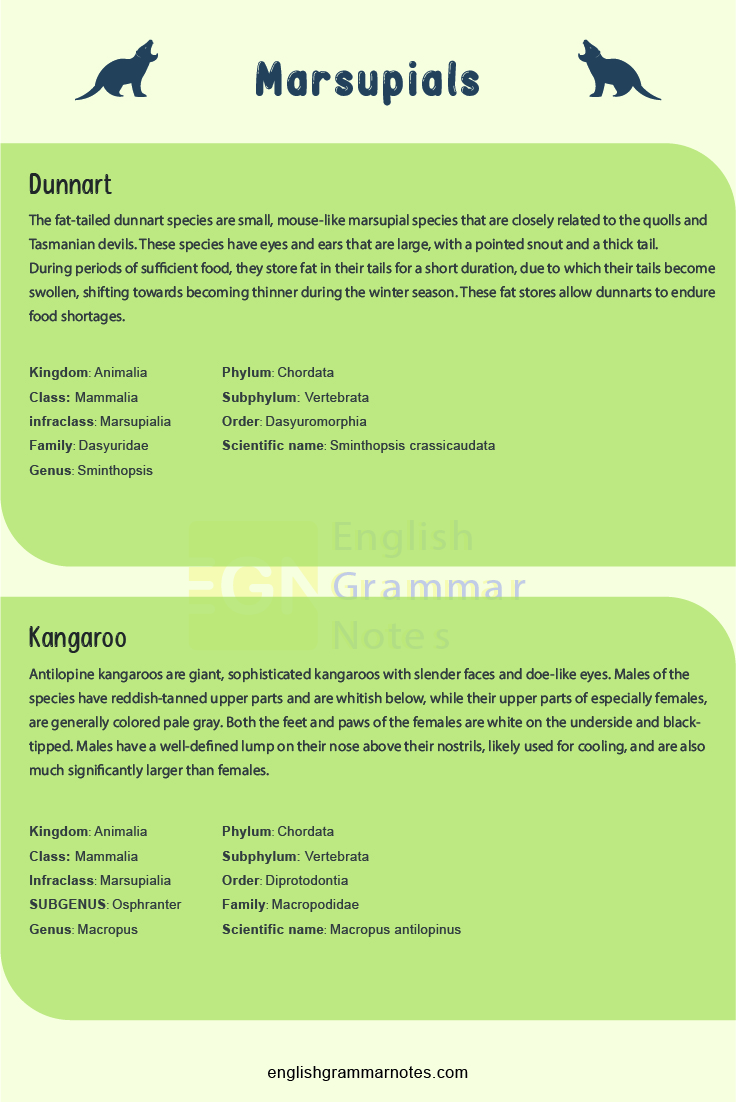
Kangaroo Rat
The Desert kangaroo rats are unique and adorable species of animals with significantly large hind legs that help them escape from predators. The Desert kangaroo rat closely resembles a tiny kangaroo and is close to the size of a mouse.
The species is so-called due to its hopping like a kangaroo, and the unusual Desert kangaroo rat is amongst the animals with the least water demand, being the animal that can live in arid conditions, getting all necessary moisture from the dry seeds it eats during the day.
It has pouches on both ends of its mouth, where it stores food. The life expectancy of this species of the Desert kangaroo rats in the wild is not currently known, but those in captivity usually live from five to eight years.
| Kingdom | Animalia |
| Phylum | Chordata |
| SUBPHYLUM | Vertebrata |
| CLASS | Mammalia |
| ORDER | Rodentia |
| FAMILY | Heteromyidae |
| GENUS | Dipodomys |
| Scientific Name | Dipodomys deserti |
Koala
Koala is a charming and quiet marsupial with a thickly-set body, tiny eyes, and large, puffy ears. The wool-like coat of this animal is thick but soft and colored with ash-grey to grey-black fur.
The densely packed fur on the ends serves as a cushion, allowing koalas to sit easily upon rough tree branches. The underparts of this species, as well as the tips of hairs on their ears, are white.
Adult male koalas have the distinctive brown-colored scent gland in the center of their chest area. One of the critical characteristics of this animal is a powerful sense of smell, which helps them differentiate between poisonous and edible leaves.
They have sharp claws on the end of their long limbs that help them climb trees and five fingers, including opposable thumbs, that allow them to grip tree branches and food easily.
| Kingdom | Animalia |
| Phylum | Chordata |
| SUBPHYLUM | Vertebrata |
| CLASS | Mammalia |
| INFRACLASS | Marsupialia |
| ORDER | Diprotodontia |
| FAMILY | Phascolarctidae |
| GENUS | Phascolarctos |
| Scientific Name | Phascolarctos cinereus |

Mulgara
The crest-tailed mulgara, whose scientific name is Dasycercus cristicauda, is a small to medium-sized Australian carnivorous marsupial species and a member of the family of Dasyuridae, which means hairy tail, and includes quolls, dunnarts, the numbat species, Tasmanian devil, and extinct thylacine species.
The crest-tailed mulgara is amongst a group of native carnivorous mammals or mesopredators exclusive to arid regions of Australia.
| Kingdom | Animalia |
| Phylum | Chordata |
| Class | Mammalia |
| Infraclass | Marsupialia |
| Order | Dasyuromorphia |
| Family | Dasyuridae |
| Genus | Dasycercus |
| Species | D. cristicauda |
| Scientific Name | Dasycercus cristicauda |
Numbat
Once widely distributed and shared throughout various regions of Australia, numbats are currently classified as an endangered species, occurring in small and dispersed populations.
This unusual marsupial species is devoid of a pouch. The numbat is a diurnal animal, which plays an essential role in the ecosystem of its habitat. In extension, this brilliant and charming animal serves as the symbol of Western Australia.
| Kingdom | Animalia |
| Phylum | Chordata |
| SUBPHYLUM | Vertebrata |
| CLASS | Mammalia |
| INFRACLASS | Marsupialia |
| ORDER | Dasyuromorphia |
| FAMILY | Myrmecobiidae |
| GENUS | Myrmecobius |
| Scientific Name | Myrmecobius fasciatus |
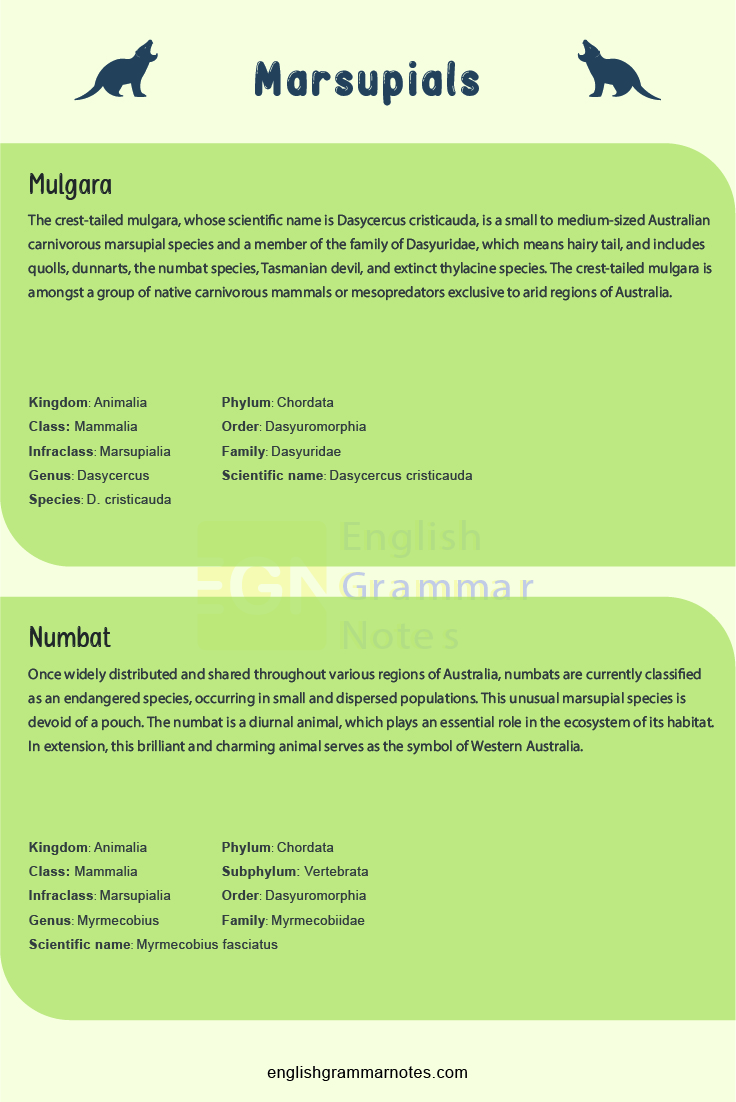
Opossum
The Virginia opossum is the single marsupial found in Northern America towards the north of Mexico. It is typically referred to usually as a possum and is quite familiar to many North American citizens as it is often seen near towns, searching through garbage cans, or as roadkill.
This species is almost the same size as a big house cat, having a triangle-shaped head with long pointed noses. The fur is grayish everywhere except its ears, tail, and its feet. Amongst their skin is longish white-tipped guard hairs.
The fur color may vary according to the population’s range. Their ears are long and delicate, and the tail is prehensile, modified for gripping and winding around tree limbs.
| Kingdom | Animalia |
| Phylum | Chordata |
| SUBPHYLUM | Vertebrata |
| CLASS | Mammalia |
| INFRACLASS | Marsupialia |
| ORDER | Didelphimorphia |
| FAMILY | Didelphidae |
| GENUS | Didelphis |
| Scientific Name | Didelphis virginiana |
Planigale
The long-tailed Planigale, whose scientific name is Planigale ingrami, is also known as Ingram’s Planigale or alternatively the northern Planigale. It is the smallest of all marsupial species and one of all mammals. It is rarely seen but is a relatively common inhabitant of the black soil plains, clayey-soiled woodlands, and seasonally inundated grasslands of Australia’s upper regions.
| Kingdom | Animalia |
| Phylum | Chordata |
| Class | Mammalia |
| Infraclass | Marsupialia |
| Order | Dasyuromorphia |
| Family | Dasyuridae |
| Genus | Planigale |
| Species | P. ingrami |
| Scientific Name | Planigale ingrami |
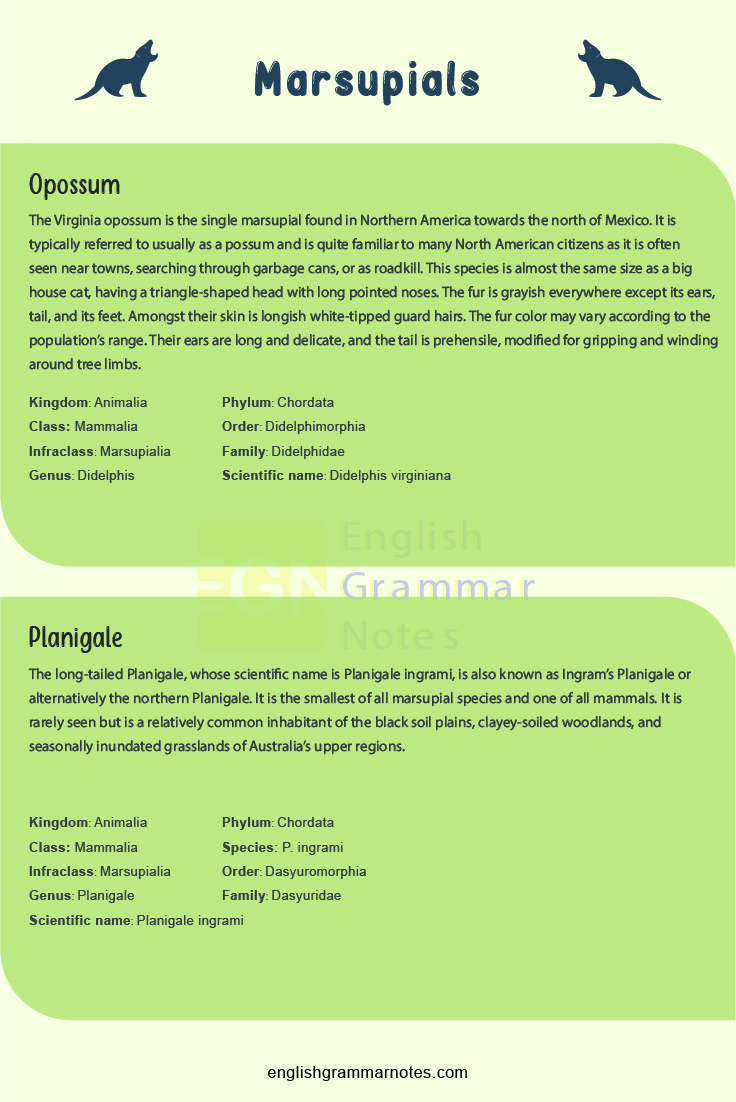
Quokka
Generally, the Quokka has a typical appearance for a wallaby: short, extraordinarily coarse, and thick fur, which is grey-brown overall with lighter under part; short tail, which is mostly without hair; and hair of its feet, which extend to the claws. Willem de Vlamingh, an early Dutch explorer, described this animal as ‘a kind of rat, as big as an ordinary cat’. The scientist first saw the Quokka on an island off the mouth of the Swan River, which he named after this animal – Rottnest (or ‘rat nest’) Island.
| Kingdom | Animalia |
| Phylum | Chordata |
| SUBPHYLUM | Vertebrata |
| CLASS | Mammalia |
| INFRACLASS | Marsupialia |
| ORDER | Diprotodontia |
| FAMILY | Macropodidae |
| SUBFAMILY | Macropodinae |
| GENUS | Setonix |
| Scientific Name | Setonix brachyurus |
Quoll
The Eastern quoll is a unique, medium-sized species of marsupial category. The animal’s fur is thick but soft, colored with fawn, brown or black, and displaying small, white patches all over the body except their tail. Generally, these quolls are seen in two distinct color patterns: fawn with whitish underparts or black with brownish underparts.
In both cases, the animals display the signature white patches. The fawn color pattern occurs more often in the species, though juveniles in the same litter may present both of these patterns.
| Kingdom | Animalia |
| Phylum | Chordata |
| SUBPHYLUM | Vertebrata |
| CLASS | Mammalia |
| INFRACLASS | Marsupialia |
| ORDER | Dasyuromorphia |
| FAMILY | Dasyuridae |
| GENUS | Dasyurus |
| Scientific Name | Dasyurus viverrinus |
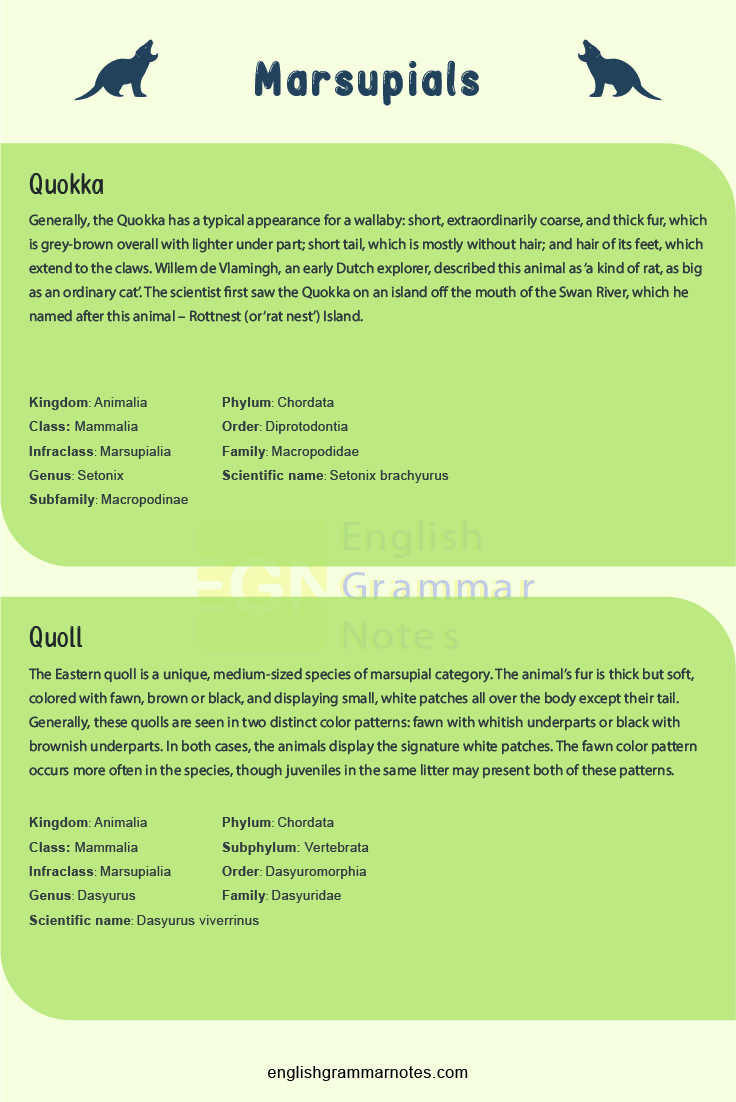
Sugar Glider
Even though these two animals are not near relatives, the sugar glider shares similar habits and appearance with the Flying squirrel species. They are the best-known glider in Australia, and this marsupial has a small, soft-furred body with a moderately bushy and prehensile tail.
The Sugar glider species are so-called due to their love for sweet food such as sugar and honey, and the word ‘glider’ applies to their gliding habit when moving between trees.
They glide using the so-called ‘patagium,’ which is a thin membrane of skin covered with fur, and this gliding membrane is located between their wrists to their ankles.
When not put to use, it looks like a wavy line that stretches along their body. Males of this unique species exhibit bare spots on their heads and chests, and females are considerably more petite than males.
| Kingdom | Animalia |
| Phylum | Chordata |
| SUBPHYLUM | Vertebrata |
| CLASS | Mammalia |
| INFRACLASS | Marsupialia |
| ORDER | Diprotodontia |
| FAMILY | Petauridae |
| GENUS | Petaurus |
| Scientific Name | Petaurus breviceps |
Tasmanian Devil
In the ancient period, these animals were once widely distributed throughout the mainland of Australia. In current times, however, the Tasmanian devil remains just a symbol of Tasmania.
The Tasmanian devil is a widespread, petite marsupial the size of a small dog. The early European immigrants call the species the devil due to its overall black color, bad-temper, and the loud and scary screeching sounds it shoots. This marsupial quite often has an aggressive behavior and is generally known for its spine-chilling calls.
Moreover, this animal has powerful jaws and teeth, enabling it to destroy its meal, including bones and fur, completely.
| Kingdom | Animalia |
| Phylum | Chordata |
| SUBPHYLUM | Vertebrata |
| CLASS | Mammalia |
| INFRACLASS | Marsupialia |
| ORDER | Dasyuromorphia |
| FAMILY | Dasyuridae |
| GENUS | Sarcophilus |
| Scientific Name | Sarcophilus harrisii |

Tree Kangaroo
Tree kangaroos are unique marsupial species of the genus of Dendrolagus, which are well adapted for arboreal locomotion. These marsupial species inhabit the tropical rainforest areas of New Guinea and far north-eastern Queensland in Australia, along with some of the islands in the region. Most tree kangaroos are deemed threatened due to hunting, poaching, and habitat destruction. They are the single true arboreal macropods.
| Kingdom | Animalia |
| Phylum | Chordata |
| Class | Mammalia |
| Infraclass | Marsupialia |
| Order | Diprotodontia |
| Family | Macropodidae |
| Subfamily | Macropodinae |
| Genus | Dendrolagus |
| Scientific Name | Dendrolagus ursinus |
Wallaby
The unique kangaroo, being its close family member, the Tammar wallabies are particular marsupials or pouched mammals and belong to the great family of macropods that means animals who have ‘large feet”.
A wallaby is a macropod that is not big enough to be classified as a kangaroo. Although there is no clear distinction between these animals, wallabies are generally smaller and stockier than kangaroos. Male wallabies have much larger forelimbs, and their claws are more expansive than those of females.
Tammar wallabies have gray to yellowish bellies and reddish legs. As with all marsupials, the female has a pouch in front of her stomach where she nurses her newborn.
| Kingdom | Animalia |
| Phylum | Chordata |
| SUBPHYLUM | Vertebrata |
| CLASS | Mammalia |
| INFRACLASS | Marsupialia |
| ORDER | Diprotodontia |
| FAMILY | Macropodidae |
| GENUS | Macropus |
| Scientific Name | Macropus eugenii |
Wombat
The Common Wombat is a unique native Australian Wombat species. The early settlers named this wombat a ‘badger’ due to its excellent burrowing skills, even though the closest relative of this particular animal is a koala. This wombat is the largest burrowing and herbivorous mammal in the whole world. The animal has a short tail and stout legs. The characteristic waddling gait and appealing features make the Common wombat one of the most fascinating and adorable animals encountered in Australia.
| Kingdom | Animalia |
| Phylum | Chordata |
| SUBPHYLUM | Vertebrata |
| CLASS | Mammalia |
| INFRACLASS | Marsupialia |
| ORDER | Diprotodontia |
| FAMILY | Vombatidae |
| GENUS | Vombatus |
| Scientific Name | Vombatus Ursinus |